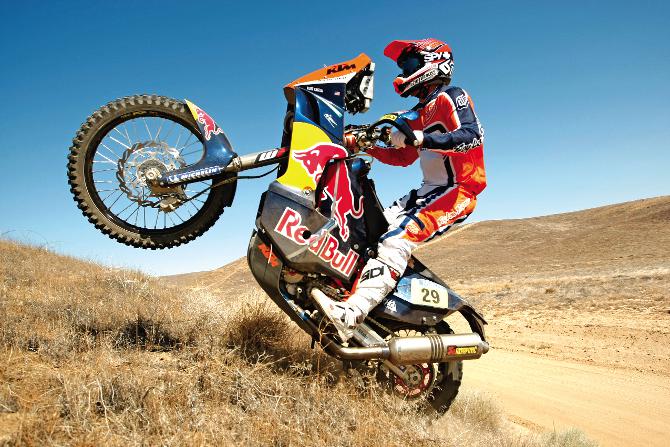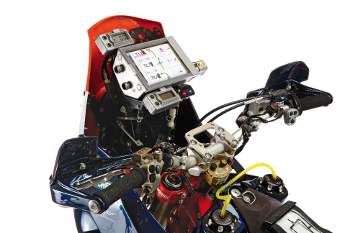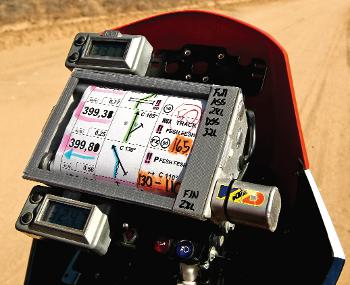WE RIDE KURT CASELLI’S STAGE-WINNING DAKAR RALLY KTM 450

| Imagine going from racing a 240-pound KTM 450SXF to racing a 380-pound bike. And not just riding it around your local track, but for 5000 miles with nine gallons of gas strapped between your legs. Kurt Caselli did it?and he did it with just a short amount of time to prepare before starting the most prestigious and grueling offroad race on earth, the Dakar Rally.
In 2013, decorated multi-time offroad champion Kurt Caselli answered the last-minute call to fill in for Factory KTM’s injured Marc Coma in the 2013 Dakar Rally just a few days before the two-week South American race was about to start. If ever there was a man up to the task, it would have to be Kurt Caselli. Caselli is one of the most versatile riders in the world. He has qualified for an AMA outdoor National, raced Endurocross main events, was the three-time WORCS Champion, finished eighth overall in the Erzberg rodeo, and is a two-time National Hare & Hound Champion and 11-time ISDE gold-medal winner. Now that is a resume. And, at the Dakar Rally, Kurt became a stage winner. And, after last year’s Dakar Rally, he signed a three-year deal to become a full-time KTM Rally racer. Prior to his untimely death in Baja late last year, Kurt was setting his sights on winning the prestigious 2014 Dakar Rally, which was watched by over 15 million television viewers worldwide. SO, WHAT’S THE MXA WRECKING CREW DOING ON A DAKAR BIKE? This bike is way off the beaten path for the MXA wrecking crew, but when Kurt Caselli called us and said that we could take his full-factory Red Bull KTM Rally bike out for a test spin, how could we say no? The privateer version of Kurt’s bike is called the KTM 450 Rally Factory Replica, and you could buy one for next year’s Dakar Rally for around $35,000. Let that be your guide as to how much money Kurt’s full-prepped KTM works version costs. We had to test it?not to expand our knowledge base, but for the thrill of it. Kurt’s Dakar bike is powered by the same engine that is in his Baja 1000 and Hare & Hound bike, but that is about the only commonality between the Dakar Rally bike and any other KTM. The Baja bike and Dakar bike are different machines?and we were focused only on the Dakar version. The Dakar bike is built for comfort, speed and navigation. The instrument panel and handlebars have a patchwork quilt of buttons and switches that control the scrolling of the road map and activate all the complex navigation equipment. Navigation is the key to success in the Dakar Rally. It doesn’t matter how fast you are if you don’t know where you are going. The instruments are man’s best friend in the lonely deserts of Peru. We didn’t want to use our normal motocross test tracks for this test, so instead we headed out to the wide-open stretches of the California desert near Kurt’s Antelope Valley home turf. We have to confess that we were scared. This was a big bike, and we got our feet wet by riding it down some desert dirt roads to get comfortable with the power and weight. As moto boys, the instrument panel bothered us. It sat high above the triple clamps and stayed stationary when we turned the bars for the corners. With the mini fairing encapsulating the front of the bike, we couldn’t see what the front wheel was doing. There was a steep learning curve, but luckily Kurt came along to show us the ropes before we started trail blazing across the desert at warp speed. Going in a straight line, whether it was sand or rough terrain, the bike tracked straight, and control was almost effortless. We would brace ourselves when we saw a rough patch of desert looming in front of us, but there was no need. The KTM Dakar Rally bike plowed through everything like a tractor. The comfort of this bike was unreal. Everything from the extra-wide footpegs to the cushy foam grips to the long, wide saddle to the plush Cadillac suspension urged us to go faster. Since Kurt had to spend eight to 14 hours a day on his bike during the Dakar rally, comfort is key. As we got more and more used to the bike, we actually began to think of the 380-pound machine as light. We started to ride it from the hips, standing up and letting the bike absorb everything that the desert threw at it. Yes, we were getting cocky. Then, we started to hit some high-speed jumps, and all of our bravado left us in a hurry. The bike may have fooled us into thinking that we were controlling it on the ground, but once we were in the air, we knew who the boss was?we were just along for the ride. And what a ride it was. We were honored to have been given the chance to ride Kurt’s bike and it was made all the more special because Kurt took the time to show us how to do it right. We will miss him.
|
 With the bike weighing over 380 pounds, Kurt needed some heavy-duty braking power. KTM equipped the bike with a 300mm front rotor that was very sensitive when applying the front brake. In the skid plate there is a 1-gallon water tank to comply with the Dakar safety regulations. The water is required just in case the rider becomes stranded in the middle of the desert.
|
 Kurt Caselli’s Dakar bike is a fullly-prepped factory racer that is unobtainable to the average rally racer, but KTM?does sell a 450 Rally Factory replica for $35,000. |
|
 Comfort is key for these long races. On the KTM Rally bikes, they run extra-long, extra-wide footpegs so the riders can rest their feet on them comfortably to lessen fatigue and strain on the body. The fuel tanks require switching to different petcocks.
|
 While Kurt is riding, he not only has to twist the throttle, use the clutch and check his navigation instruments, but he also uses the buttons on the bars to scroll up and down on his road map and switch through his other instruments.
|









Comments are closed.